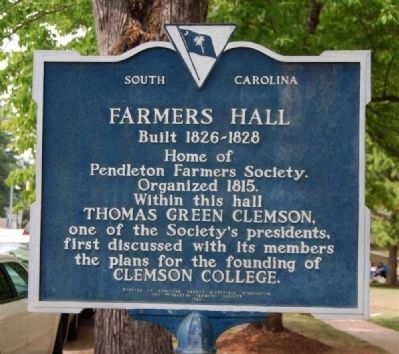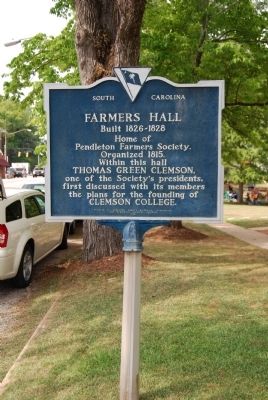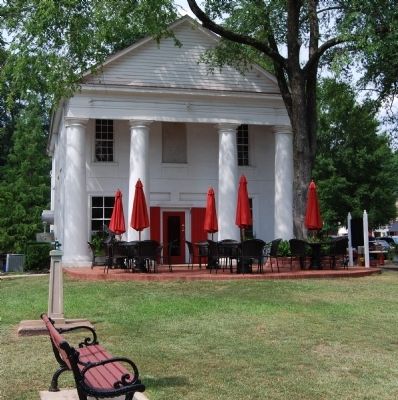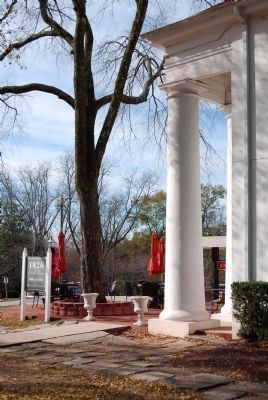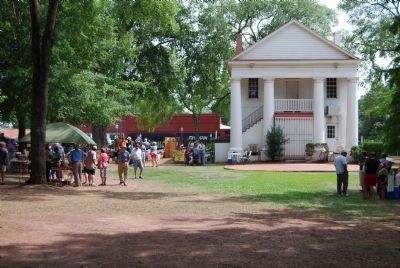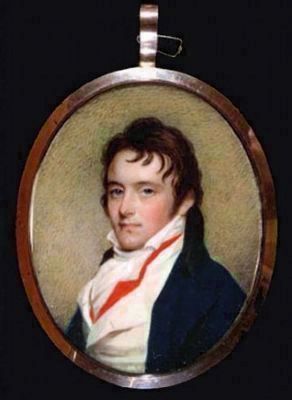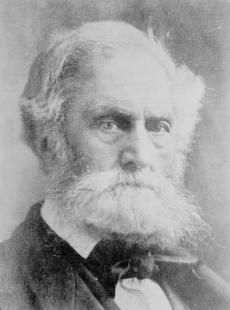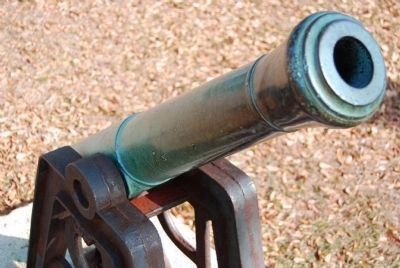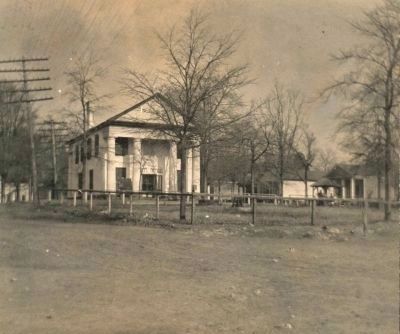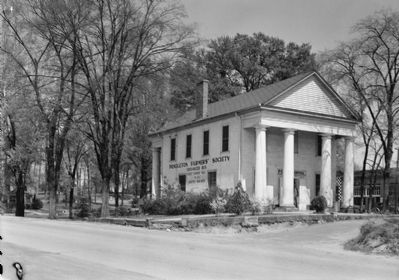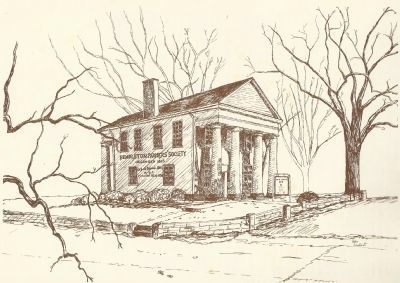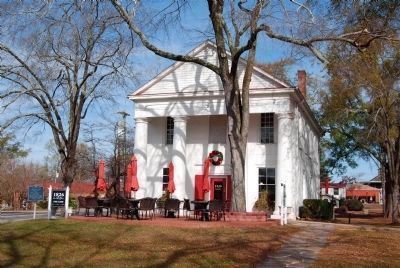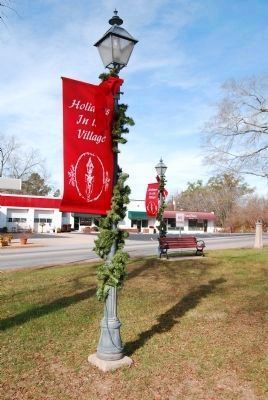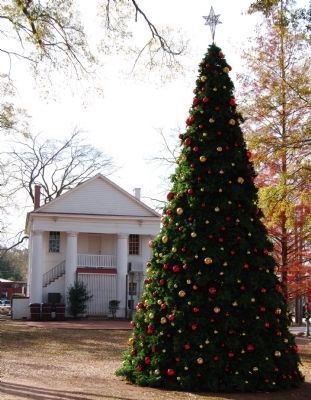Pendleton in Anderson County, South Carolina — The American South (South Atlantic)
Farmers Hall
Home of
Pendleton Farmers Society.
Organized 1815.
Within this hall
Thomas Green Clemson,
one of the Society's presidents,
first discussed with its members
the plans for the funding of
Clemson College
Erected 1958 by Anderson County Historical Association and Pendleton Farmers Society. (Marker Number 4-4.)
Topics and series. This historical marker is listed in these topic lists: Agriculture • Education • Fraternal or Sororal Organizations. In addition, it is included in the South Carolina, Anderson County Historical Association/Society series list. A significant historical year for this entry is 1815.
Location. 34° 39.042′ N, 82° 47.031′ W. Marker is in Pendleton, South Carolina, in Anderson County. Marker is on North Mechanic Street (State Highway 28) near West Main Street, on the right when traveling north. Marker is located on the Town Square, near the southwestern corner (intersection of Mechanic and Main Streets). Touch for map. Marker is in this post office area: Pendleton SC 29670, United States of America. Touch for directions.
Other nearby markers. At least 10 other markers are within walking distance of this marker. Old Mill Stone (within shouting distance of this marker); Health & Heritage Walking Trail (about 300 feet away, measured in a direct line); Hunter's Store (about 400 feet away); Pendleton (about 400 feet away); Printer John Miller (approx. 0.2 miles away); African American School Site (approx. 0.2 miles away); "The Hundreds" (approx. 0.2 miles away); Thomas Green Clemson (approx. 0.4 miles away); Clement Hoffman Stevens (approx. 0.4 miles away); a different marker also named Thomas Green Clemson (approx. 0.4 miles away). Touch for a list and map of all markers in Pendleton.
Also see . . .
1. Pendleton landmark Farmer's Hall to reopen in June. May 11, 2008 Anderson Independent-Mail article about the opening of 1826 On the Green at Farmer’s Hall Restaurant in the first floor of Farmer's Hall. (Submitted on September 14, 2008, by Brian Scott of Anderson, South Carolina.)
2. 1826 on the Green...Pendleton's Front Porch Restaurant. Balanced by both culinary expertise and natural aesthetics, 1826 on the Green offers a rich, flavorful experience for all your senses. (Submitted on November 16, 2008, by Brian Scott of Anderson, South Carolina.)
3. Pendleton District. Pendleton District is a former judicial district in South Carolina. It existed as a county or a district from 7 March 1789 to 20 December 1826. (Submitted on November 16, 2008, by Brian Scott of Anderson, South Carolina.)
4. Pendleton Historic District. Pendleton, original county seat of Old Pendleton District (now Anderson, Oconee, and Pickens counties) is one of South Carolina’s earliest upcountry towns. (Submitted on September 30, 2010, by Brian Scott of Anderson, South Carolina.)
5. Clemson University. University website homepage (Submitted on November 16, 2008, by Brian Scott of Anderson, South Carolina.)
6. Thomas Green Clemson. Thomas Green Clemson, IV (July 1, 1807 – April 6, 1888) was an American politician and statesman, serving as an ambassador and the United States Superintendent of Agriculture. (Submitted on November 16, 2008, by Brian Scott of Anderson, South Carolina.)
Additional commentary.
1. Farmer's Society Hall
Twenty-nine prominent men of Pendleton founded the Pendleton Farmer's Society in 1815. Thomas Pinckney, Jr., was its first president. There were other organizations before this, but these men finished building the first permanent farmer's society hall in the United States in 1828. The Society had bought the unfinished new courthouse whose construction
was halted when Pendleton District was divided into Anderson and Pickens counties. The building is a handsome two-story structure of Greek revival architecture with four massive two-story white columns on two sides. It is well preserved and is still used.
The Farmers' Society roll through the years reads like a "who's Who" in this area. Both John C. Calhoun and Thomas Green Clemson served as presidents of the organization.
The Pendleton Farmer's Society became the mane spring in the agricultural development of this area. It served to introduce and promote improved methods of farming and rural living. It was a social and scientific agricultural organization and has continued to be until his day. As early as 1816 it conducted the Pendleton Fair where different breeds of cattle and other livestock were shown and judged. At the fair all manner of produce and home-grown and home-prepared products such as home-woven cloth, bedspreads, clothing, preserves, cakes and handicrafts were displayed. The Society has promoted production contests in many crops, trips, lectures and demonstrations on scientific agriculture and took part in the founding of Clemson Agricultural and Mechanical College in 1899, which institution of learning, having grown beyond all its founder's dreams, in 1964 became Clemson University. (Source: Anderson County Sketches, The Anderson Tricentennial
Committee, 1969.)
Because of relatively poor agricultural practice in the early 1800s, several plantation owners sought better methods. Pendleton boasted one of the state's first local agricultural societies, the Pendleton Farmers' Society organized in 1815...membership, judged by land ownership, slave holdings, and social and political prominence, drew primarily from the upper crust of plantation owners. (Source: African American Life in South Carolina's Upper Piedmont, 1780-1900, W. J. Megginson, Univ of South Carolina Press, 2006.)
— Submitted August 27, 2008, by Brian Scott of Anderson, South Carolina.
2. Pendleton Farmers' Society Events
Pendleton Farmers' Society held annual exhibitions and awarded prizes for best livestock, crop specimens, productivity, and domestic industries. It also presented occasional lectures on agricultural management, which seldom went beyond advice to take care of the land and to plant widely. (Source: African American Life in South Carolina's Upper Piedmont, 1780-1900, W. J. Megginson, Univ of South Carolina Press, 2006.)
— Submitted January 3, 2009, by Brian Scott of Anderson, South Carolina.
3. Thomas Pinckney, Jr., 1st President of the Pendleton Farmers Society
Thomas Pinckney, Jr. was well connected through his family. He father was Thomas Pinckney, Sr., a veteran of both the American Revolutionary War and the War of 1812. His uncle, Charles Cotesworth Pinckney the Elder, and his second cousin, Charles Pinckney, were signers of the US Constitution. His wife, Elizabeth Izard, was a cousin twice removed of South Carolina Congressman Ralph Izard. Phoebe Elliott, the wife of his brother Charles Cotesworth Pinckney the Younger, was a daughter of a South Carolina State Representative, William Elliott. Pinckney also had a home in Charleston, located at 114 Broad Street, which was used as the headquarters of Gen. Pierre G. T. Beauregard from the end of August 1863, to December 1863.
— Submitted January 3, 2009, by Brian Scott of Anderson, South Carolina.
4. Thomas Green Clemson, President of the Pendelton Farmers Society
Thomas Green Clemson IV, Clemson was more than just the founder of Clemson University. He serving as U.S. charge d'affaires to Belgium from 1844 to 1851 and was the United States Superintendent of Agriculture until he resigned at the start of the Civil War. Clemson returned to Pendleton where he addressed the Farmers Society with these words: "[I] Urge[d] the establishment of a department
of agriculture in the government of the Confederate States which, in addition to fostering the general interest of agriculture, would also serve as a sort of university of the diffusion of scientific knowledge and the improvement of agriculture." Outliving his wife and children, Clemson died on April 6, 1888 and is buried in nearby St. Paul's Episcopal Church Cemetery. Provisions in his will allowed for the establishment of a "land grant" institution, known today as Clemson University.
— Submitted January 3, 2009, by Brian Scott of Anderson, South Carolina.
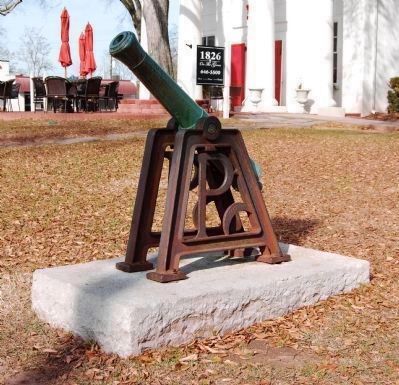
Photographed By Brian Scott, November 27, 2008
8. Cannon Located on the Village Green Near Exchange Street
The cannon, known as a "Red Shirt" cannon, was placed on the square in 1907. During the 1950s, the cannon was "borrowed" by Clemson cadets and taken to the Furman Campus where it was loaded with blanks and fired. Reports are that the shock was so strong, it blew out windows in the Furman neighborhoods.
Credits. This page was last revised on January 31, 2022. It was originally submitted on July 26, 2008, by Brian Scott of Anderson, South Carolina. This page has been viewed 6,815 times since then and 171 times this year. Photos: 1. submitted on September 30, 2010, by Brian Scott of Anderson, South Carolina. 2, 3. submitted on July 26, 2008, by Brian Scott of Anderson, South Carolina. 4. submitted on November 27, 2008, by Brian Scott of Anderson, South Carolina. 5, 6, 7. submitted on November 16, 2008, by Brian Scott of Anderson, South Carolina. 8, 9. submitted on November 27, 2008, by Brian Scott of Anderson, South Carolina. 10. submitted on January 2, 2009, by Brian Scott of Anderson, South Carolina. 11. submitted on January 3, 2009, by Brian Scott of Anderson, South Carolina. 12. submitted on January 30, 2012, by Brian Scott of Anderson, South Carolina. 13, 14, 15. submitted on November 27, 2008, by Brian Scott of Anderson, South Carolina. • Kevin W. was the editor who published this page.
